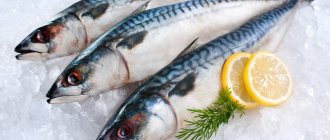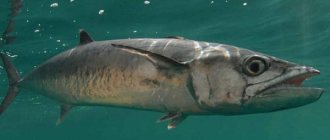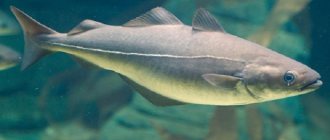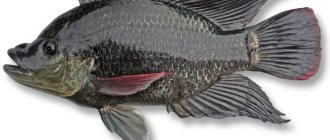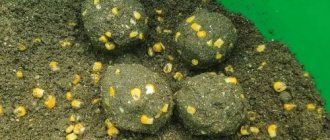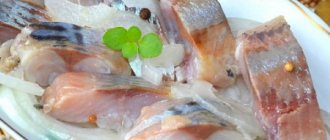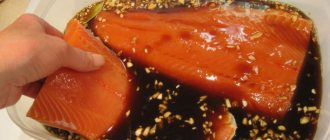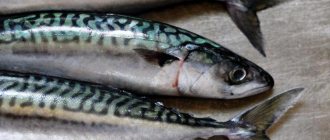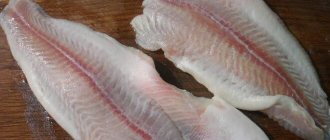Mackerel is a medium-sized fish, on average 30 cm in length, with a characteristic striped back and light golden belly.
It is well known to us from fish deli stores, where it is sold after hot or cold smoking. This tasty fish is often served as an appetizer, but can also be a main dish. We'll tell you where mackerel is found, what it eats, and what it is like. How do you prefer to cook mackerel?
- Salt/smoke 40%, 451 votes
451 votes 40%451 votes - 40% of all votes
- Bake in the oven 35%, 388 votes
388 votes 35%
388 votes - 35% of all votes
- Fry in a pan 9%, 96 votes
96 votes 9%
96 votes - 9% of all votes
- Stew with vegetables 6%, 69 votes
69 votes 6%
69 votes - 6% of all votes
- I don’t cook mackerel 4%, 42 votes
42 votes 4%
42 votes - 4% of all votes
- In a slow cooker 3%, 39 votes
39 votes 3%
39 votes - 3% of all votes
- Prepare first courses 3%, 30 votes
30 votes 3%
30 votes - 3% of all votes
Total votes: 1115
17.04.2020
×
You or from your IP have already voted.
Where does it live in Russia?
It belongs to marine fish and is not found in fresh water bodies. Its habitat is the water column, where a lot of plankton and small fish swim. Heat-loving mackerel prefers water with a temperature of 10-20 degrees. Colder water is detrimental to this fish: at +6...+9 degrees its activity and metabolism slow down, and a temperature of +2 degrees is detrimental to it, the fish falls asleep and drowns in a matter of seconds. Therefore, it cannot be found in polar waters. Its habitat is almost all warm seas and currents. There are not many mackerel in Russia; our waters are too cold for this fish. But there are regions where industrial fishing is carried out.
A large mackerel fishing area was in the Far East. It began to be caught here in the 1960s, but in the late 1980s it became so scarce that industrial fishing lost its meaning, so since 1990, fishing has stopped completely.
Only amateur fishing remains in the Black Sea. Until the 70s, mackerel was caught here commercially, but then large migrations stopped. One of the reasons for this was the difficulty in crossing the Bosphorus Strait, which is polluted by runoff from Istanbul, and this fish is sensitive to the purity of the water. The cessation of mass migration of mackerel to the Black Sea has led to a significant decline in the species of marine fauna in this region. After all, along with the shoals of mackerel, large predators - tuna, swordfish and others - stopped coming here. The fish that used to enter the Black Sea now spawn in Mramornye.
There is a list of three habitats in the Atlantic Ocean where mackerel are found:
- northern - feeding leads in the Norwegian Sea, in the northern branches of the warm Gulf Stream current. This fish is caught here by trawlers from Murmansk;
- western - lives to the west and northwest of the British Isles, reaching the coast of Iceland;
- southern - living south of the British Isles all the way to the west coast of Africa.
The northern and western populations are fatter, and therefore more valuable than the southern ones. These populations are caught in the Baltic Sea, where the fish come to feed. In Russia, schools of mackerel also enter the White and Barents Seas, and industrial fishing is possible there. It enters the northern seas in warm years. Under favorable conditions, you can find schools of it even in the Gulf of Finland, but closer to fresh water bodies and even in estuaries and similar highly desalinated places, you won’t find it: river water makes it impossible for fish to reproduce and is detrimental to the fish itself.
Fish in children's diets
Seafood is a strong allergen, so you should be careful when introducing them into your child’s complementary foods; before starting it, you should consult with your pediatrician to select safe products. If you still decide to take this step, then there are certain serving norms according to the baby’s age: 1 year – up to 70 grams once a week; 1.5 years – up to 90 grams 2 times a week; from two years – 100 grams.
Important! Mackerel is not recommended to be included in a child's first complementary food, as it has a high percentage of fat content.
“Fish Day” will become a very good tradition for the family; it will not only unite your family at the table, but will also bring variety to your diet. Question: “ mackerel an oily fish or not?” » is not even asked when choosing fish. Today there are a huge number of recipes for its preparation. Since its meat is very tender, fatty and without small bones, it can be stewed, baked, stuffed with vegetables, fried, grilled and even used as a shish kebab.
To ensure that your dish doesn’t spoil anyone’s mood, we will tell you how to choose fresh fish:
- buy fish in places strictly designated for its sale, as it tends to spoil quickly, and this is dangerous to health;
- the body of the fish should be moist and elastic, without visible mechanical damage. When you press on the back with your finger, the dent should quickly disappear, and the tail should not be dried out;
- put fresh fish on your palm, not fresh fish will hang from your palm, but fresh fish will remain lying horizontally on the surface, while spoiled fish will have dull, sunken eyes, it is dull, has a strong aroma, such a product should be avoided, and even better, inform the store management about the violation trading rules;
- the main criterion is the gills - in mackerel they should be bright burgundy, without white mucus;
Reproduction and lifespan
Mackerel lives in schools, in which fish of approximately the same size and, accordingly, age gather. Flocks migrate, primarily in search of water at a comfortable temperature.
Mackerel begins to reproduce at the age of 3, and the lifespan of one fish is 18-20 years or more. The spawning period depends on the age of the fish: adults begin breeding in mid-spring, young fish - in early summer. Comfortable depth for spawning is 190-210 meters. The number of eggs that the female lays depends on the species, but they are always so small that it is impossible to see them with the naked eye. They swim in warm water until the larvae hatch.

The larvae develop from the eggs in 10-20 days, the exact time depends on the water temperature. The warmer it is, the faster development occurs. In the first weeks of their existence, the larvae and fry eat literally everything they can find. The mackerel retains its gluttony even in adulthood, but the most severe natural selection occurs among the fry: the stronger ones also feed on weaker relatives.
The most active growth occurs in the first six months: the fry, hatched in the spring, reach a length of 18 cm by October. When the fry reach a body length of 3 cm, they exhibit school behavior and begin to migrate.
Fishing Features
Mackerel is a valuable animal in the fishing industry. It is caught en masse using seines, longlines and gill nets.
Due to overfishing, some fish species are on the verge of extinction.
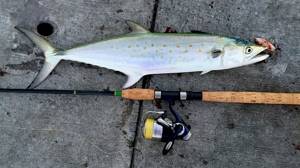
Amateur fishermen are also not averse to catching a fish or two for dinner.
The population has declined in the last couple of decades. Therefore, the fish were taken under protection. Poaching and mass trapping are prohibited.
It is better to fish from a boat or yacht. Use a match rod, float rod or spinning rod. Suitable for bait:
- tyrant - hooks decorated with bright objects: foil, multi-colored feathers, etc.;
- artificial baits, which are sold in fishing stores;
- small freshly caught fish up to 30 cm in size;
- shellfish;
- any fish cut.
Kinds
In some sources, mackerel and mackerel, including king mackerel, are called the same fish. The confusion in the names arose due to the fact that in English these two species of fish belonging to the mackerel family are called by the same word mackerel. Sometimes the British give the same name to tuna, but tuna is definitely not mackerel, it just belongs to the same family.
Mackerel is a separate genus of predatory perch-like fish of the mackerel family. The king can be distinguished by the fact that it is twice the size of mackerel, for which 60 cm is the maximum length, and for mackerel it is the average. The mackerel has markings on its belly. From a culinary point of view, mackerel is a less fatty and less valuable fish. It is not so good with gourmet cooking methods - salting, smoking and baking. Most often, they try to deceive the buyer by passing off mackerel as a special mackerel. But all representatives of this genus are similar to each other, and mackerel are easy to distinguish from them, which significantly reduces the list of subspecies of the family.
There are 4 known species of mackerel. These are Atlantic, Japanese, African and Australian. They are all very similar to each other. The Atlantic has important anatomical differences from other species, and the rest differ from each other insignificantly in the eyes of a non-specialist.
Natural enemies of mackerels
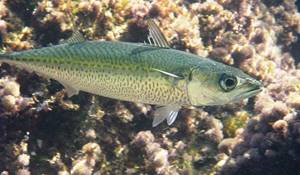
Photo: What mackerel looks like
Many predatory fish and other marine animals prey on mackerel.
Among them:
- sharks;
- dolphins;
- tuna;
- pelicans;
- sea lions.
Despite the fact that it swims quickly, it is difficult for it to escape from such large predators simply because of the difference in size. Therefore, when such large fish attack, the school can only rush in different directions. In this case, each individual can only count on the fact that the predator will not go in pursuit of it.
At the same time, the predators themselves can attack in groups at once, and then the school of mackerel suffers very much; in one such attack it can be reduced by a quarter. But in mixed schools, other fish are usually at greater risk, because mackerel are faster and more maneuverable.
When the fish finds itself at the very surface of the water, it begins to be threatened by attacks from large birds and marine mammals. Sea lions and pelicans especially love it. Even when they are full of other prey, they often wait for mackerel, because its fatty meat is a delicacy for them.
Interesting fact: When buying frozen mackerel, it is important to pay attention to several signs that can help you understand that it was stored correctly and is not expired. The mackerel should be shiny and elastic, without wrinkled areas on the skin - this indicates that it has not been defrosted previously.
The meat should be creamy in color. If it is too pale or yellowish, the fish was caught too long ago or was defrosted during storage or transportation. A large amount of ice indicates improper storage, so the meat will most likely turn out to be loose.
Atlantic
Typical view. These are fish with an average length of 30-40 cm, weighing 1-1.5 kg. They can reach a maximum length of 58-63 cm, weight – 1.7 kg. Although it is impossible to say exactly what the largest specimen of mackerel caught is - it is caught with nets and the total weight of the catch is calculated.

Looking at the photo, it is impossible not to identify the fish depicted on it. The body of this species is spindle-shaped, the muzzle is pointed. The back is painted in blue-green colors. There are wide, twisted dark stripes across the back, imitating the shadows of bottom plants. The sides and belly are light golden, plain, without markings. The transition between dark and light colors is sharp. The fins are well developed and hard. The teeth are small, adapted for eating small prey.
Atlantic mackerel does not have a swim bladder. Fish need this organ to regulate the depth of their dive. Those species that lack it are forced to adapt differently. Sharks are forced to constantly move; if they stop, they will begin to sink to depth. In Atlantic mackerel, fat takes over the function of maintaining the body in water. The absence of a swim bladder gives the fish an advantage - the ability to accelerate quickly. It is capable of reaching a speed of 80 km/h in 2 seconds. This property helps the fish hunt more successfully and stay alive after encounters with predators. This is impossible with a bubble - with a sharp acceleration, the gas comes out of it, and the fish goes to the bottom.
The marching speed of a school of mackerel is 20-30 km/h. The fish can maintain this pace for hours, provided there is plenty of food.
Features and habitat of mackerel
Mackerel fish belongs to the order Mackerelidae of the mackerel family. The average body length of this aquatic creature is about 30 cm, but in nature there are often individuals more than twice as long, reaching a weight of up to 2 kg.
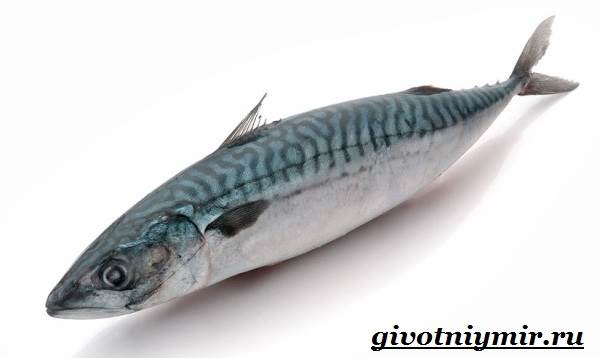
However, small specimens can weigh only 300 g. The head of the fish has the shape of a cone, the body is shaped like a spindle, covered with small scales, in the tail part it is thin and laterally compressed. The body color is silver, marked with dark transverse stripes, the back is greenish-blue.
In addition to the usual dorsal and pectoral fins, mackerel has five rows of additional fins, of which the caudal one is widely forked. Like many representatives of the mackerel family, in such a fish it is possible to distinguish a bony ring around the eyes. The snout of these aquatic animals is pointed, the teeth are conical and small in size.
Mackerel are divided into four main varieties. Among the species of mackerel, African ones reach the largest sizes. The length of such individuals can be equal to 63 cm, while the weight can exceed two kilograms.
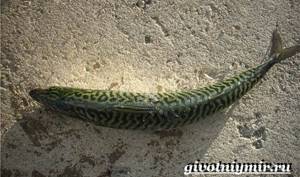
The smallest (44 cm and 350 g) is the blue or Japanese mackerel. In addition, the following types of such fish are known: common Atlantic and Australian. Mackerel occupy an oceanic territory that has spread to all parts of the world except the Arctic Ocean. Schools of such fish swim into various seas, for example, they migrate to the waters of the White Sea, and mackerel also lives in the inland depths of the Baltic, Marmara, Black and other seas.
Japanese
Look at the photo: at first glance, Japanese (sometimes called Pacific or Far Eastern) mackerel looks exactly like its Atlantic relative. She has the same characteristic color. There are nuances in the structure of the fins and teeth, but the main difference lies inside. Japanese mackerel, like other species except the Atlantic, have a swim bladder, and they move much more slowly than their Atlantic relatives. There are also external differences - a more pointed muzzle, a different shade (in addition to the blue-green main color, the Japanese species also has blue variants). During 1 spawning, it lays about 1 million eggs.
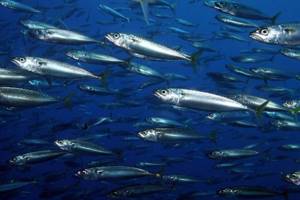
African
For a long time it was considered a variety of Pacific mackerel, but has now been isolated as an independent species. It looks almost like the Japanese mackerel, but differs from it in the large number of spines in the first dorsal fin, sometimes in fewer rays in the posterior dorsal fin, and in the fact that African mackerels always have only one row of palatal teeth, while Japanese mackerels can double it. African mackerel is one of the most prolific; it lays up to 2.6 million eggs during spawning. Lives near the Canary and Azores Islands.
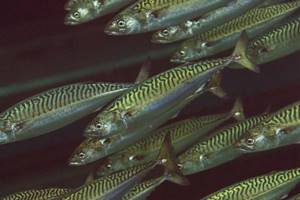
How is mackerel beneficial for the human body?
It is recommended to consume mackerel:
- For children for brain activity.
- For teenagers, so that organs form correctly.
- Women during pregnancy and breastfeeding.
- Everyone else to keep the body healthy.
What are the benefits of mackerel fish?
The elements that make up the delicacy nourish not only the stomach, but also the body.
Thanks to the healing elements in the body of lovers of this fish, proteins necessary for life are synthesized, bone and joint tissue becomes stronger, and many important processes (for example, metabolism) return to normal.
Due to the large amount of phosphorus present in the product, mackerel is an excellent “catalyst” for many beneficial chemicals. transformations and reactions.
In addition, it is phosphorus that helps our musculoskeletal system work well.
Also mackerel:
- Destroys sclerotic plaques in the vascular system.
- Strengthens the central nervous system and immune system.
- Regulates blood sugar levels.
- It has a beneficial effect on the organs of vision and memory.
It must also be said that consumption of mackerel fish has a beneficial effect on the performance of the digestive system and all areas of the brain.
In addition, mackerel is good for hair and skin (improves aesthetics).
Fish helps DNA synthesis and has a positive effect on the mucous membrane and the functioning of the spinal cord.
Energy value and chemical composition
The calorie content of raw mackerel is attractive - 191-205 kcal per 100 g. But it is not eaten raw, and the calorie content when cooked is significantly different.
| Mackerel | kcal | squirrels | fats | carbohydrates |
| Raw Atlantic | 205 | 18,6 | 13,89 | 0 |
| Raw Far Eastern | 239 | 19,3 | 18 | 0 |
| Salty | 305 | 18,5 | 25,1 | 0 |
| Cold smoked | 150 | 22,4 | 9,94 | 0 |
| Hot smoked | 258,6 | 21,16 | 18,79 | 1,82* |
| Boiled | 211 | 19,6 | 14,7 | 0 |
| Baked | 167 | 17,1 | 10,3 | 0 |
| Fried | 218,3 | 17,1 | 15,9 | 1,8 ** |
* carbohydrates come from sugar, which is used for marinade before smoking
** if breading was used.
Mackerel is rich in B vitamins, especially B12; it contains 8.7 mcg of this beneficial compound per 100 g, or 363% of the daily intake of an adult. It also contains a lot of vitamin D - 16.1 mcg or 107.3% of the norm.
Of the minerals, mackerel meat is rich in selenium; 100 g contains 44.1 mcg, or 88% of the daily requirement.
In mackerel meat, saturated fatty acids (“bad” cholesterol) are only 3.26 g per 100 g, but monounsaturated and polyunsaturated (“good” cholesterol) are 5.46 and 3.35 g, respectively.
Smoked mackerel is said to be the healthiest. But naturally smoked products, both hot and cold, contain dangerous substances that, if consumed excessively, provoke the development of cancer. There is controversy surrounding the imitation of smoking using “liquid smoke” - carefully filtered fractions of smoke from the combustion of wood or coal. Therefore, if you are looking after your health, smoked mackerel should be treated as a delicacy. It has a rich, rich taste, and eating smoked meats in small quantities on holidays is not harmful, but it is better not to introduce them into the diet on an ongoing basis. For a healthy diet, fish prepared in the usual way is more suitable: grilled, baked or steamed.
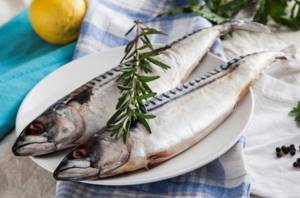
Why is mackerel valuable?
At first glance, mackerel meat may seem unappealing. It is a repulsive gray color, not too greasy and hard. However, fish fillet is a storehouse of useful vitamins and minerals.
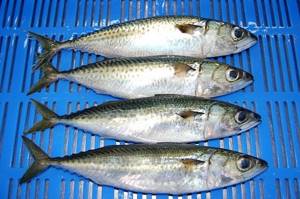
Just 300 g of fish will fill the daily need for phosphorus, and 400 g for potassium.
The most valuable is mackerel caught in northern latitudes in winter. It is fatty and contains a maximum of useful elements.
Regular consumption of mackerel contributes to:
- reducing the risk of developing cancer, diseases of the cardiovascular and respiratory systems, type 2 diabetes;
- preventing arthritis and psoriasis;
- increased life expectancy - thanks to beneficial fatty acids and coenzyme Q10;
- strengthening the walls of blood vessels and preventing thrombosis;
- maintaining healthy joints and bones;
- prevention of anemia and assistance in the fight against anemia due to the high content of vitamin B12 and iron;
- normalization of the thyroid gland - thanks to iodine;
- strengthening potency due to the presence of zinc;
- improvement of skin, hair, nails.
Due to the fluorine and phosphorus content, mackerel fish is a natural prevention of oral diseases. It strengthens the enamel, prevents the development of caries, wedge-shaped defects, pathological abrasion, and strengthens the gums.
Mackerel is good for everyone. It is strongly recommended that elderly people, children, pregnant women, and patients with chronic pathologies use it regularly. However, it should be given to children under 9 years of age with caution due to possible allergies.

